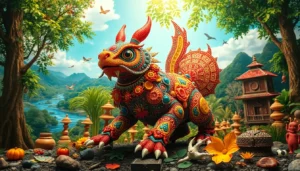Table of Contents
ToggleIn the glamorous world of fashion, the 1950s stand out as a decade of elegance and innovation, with Dior leading the charge. Picture this: cinched waists, full skirts, and fabrics that whispered luxury. Christian Dior didn’t just create clothes; he crafted dreams that danced down runways and into the hearts of style icons everywhere.
From the iconic New Look to jaw-dropping evening gowns, Dior’s haute couture pieces defined a generation. It wasn’t just about looking good; it was about feeling like a million bucks while navigating the complexities of post-war life. So grab your vintage sunglasses and let’s dive into the exquisite realm of 1950s Dior, where every stitch tells a story and every dress is a masterpiece waiting to be unveiled.
Overview of Haute Couture Dior 1950s
Haute couture in the 1950s under Christian Dior revolutionized fashion. This era introduced the iconic New Look, which featured sharply defined silhouettes. The emphasis on cinched waists and voluminous skirts characterized this signature style, marking a significant departure from the wartime austerity in clothing.
Elegance became a defining trait of Dior’s creations. Fabrics such as silk, taffeta, and organza shaped the luxurious feel of garments. Each piece brought forth intricate details, showcasing the craftsmanship synonymous with haute couture. Designs often included embellishments like embroidery and beading, enhancing the appeal of the garments.
Collections during this decade highlighted the interplay between femininity and opulence. Floral patterns and soft pastel colors dominated the runway, contrasting the harsher lines of previous fashions. Many dresses exuded a sense of romance, making them not just clothing but expressions of individuality.
Models in Dior’s shows enacted the designer’s vision, reinforcing the era’s embrace of glamour. The connection between clothing and empowerment resonated deeply, as women donned these exquisite designs to elevate their stature. Furthermore, fashion magazines celebrated Dior’s work, showcasing stunning visuals that captured public interest.
In Paris, the influence of Dior extended globally. His designs set standards that many other fashion houses strived to emulate. Icons like Grace Kelly and Audrey Hepburn frequently wore his creations, solidifying their significance in popular culture.
Through a focus on luxury, Christian Dior’s haute couture in the 1950s left an indelible mark on fashion history. Attention to detail, innovative design, and a deep understanding of female desire defined this transformative period. Each collection is a testament to Dior’s ability to craft not just clothing but wearable art.
Iconic Collections and Designs

Christian Dior’s haute couture in the 1950s featured groundbreaking collections that captured the essence of elegance. Each collection brought forth unique designs that set new standards in the fashion industry.
The New Look Revolution
The New Look debuted in 1947, transforming fashion in the following decade. This signature style emphasized a nipped waist and voluminous skirts, redefining femininity. Couturiers embraced luxurious fabrics, including silk and taffeta, enhancing the allure of the silhouette. Showcasing craftsmanship, garments from this collection exuded sophistication and glamour, embodying the spirit of post-war luxury. Models projected confidence and grace, making the New Look an instant classic. Many renowned figures in the fashion world recognized the impact, subsequently influencing design trends around the globe.
Key Pieces from the Era
Key pieces from Dior’s collections exemplified the hallmark of haute couture during the 1950s. The Bar suit remains an emblematic design, featuring a tailored jacket and a full skirt, highlighting the ideal feminine form. Cocktail dresses adorned with intricate embroidery showcased artistry and detail, captivating the fashion elite. Also, iconic Day dresses featured playful patterns and were perfect for everyday elegance. Each piece told a story, representing the artistry that Dior infused in his creations. Celebrities and socialites alike sought these designs, reinforcing the status of Dior as a leader in modern fashion.
Influential Designers and Collaborators
Dior’s haute couture in the 1950s thrived due to the synergy of visionary designers and key collaborators. Together, they shaped an era marked by elegance and sophistication.
Christian Dior’s Vision
Christian Dior emphasized femininity and luxury through his designs. The New Look initiated a transformation that celebrated the female silhouette, combining elegance with glamour. Silhouettes often featured nipped waists and full skirts, embodying the post-war longing for opulence. Craftsmanship took center stage, with meticulous details that elevated each garment. Fine fabrics like silk and taffeta reflected his commitment to quality, appealing to a clientele ready to embrace style after years of austerity. Strongly believing in fashion’s power, Dior created garments that empowered women, making each piece a statement of grace and modernity.
Notable Collaborations
Dior collaborated with several influential figures in the fashion industry. Designers such as Pierre Cardin and Yves Saint Laurent, both young talents, gained exposure under Dior’s mentorship. Their contributions to the couture process enriched the creative landscape, enhancing the overall quality of the collections. Collaborations with renowned artists and illustrators like René Gruau brought a visual vibrancy to Dior’s fashion shows, creating striking promotional imagery. Models of the era, including Dovima and Jean Patchett, showcased these iconic designs on the runway, establishing a connection between haute couture and celebrity. Each collaboration expanded the reach of Dior’s vision, cementing its place in fashion history.
Impact on Fashion and Society
Christian Dior’s haute couture in the 1950s reshaped women’s fashion and societal norms. The New Look, introduced in 1947, had enduring effects, reinforcing ideals of femininity and elegance. Silhouettes that featured cinched waists and full skirts became synonymous with a new standard of beauty. Luxury fabrics like silk and organza defined social status, creating a desire for haute couture among the elite.
Societal shifts occurred as well; women embraced their identities during this period. Dior’s designs provided a sense of empowerment, allowing women to express their individuality through fashion. Models like Dovima and Jean Patchett became icons, further glamorizing the life surrounding haute couture and influencing public perception.
Fashion magazines celebrated Dior’s creations, generating heightened interest in designer clothing. Readers admired not just the garments but also the stories behind them, linking fashion to personal narratives. Socialites and celebrities donned Dior pieces, reinforcing his status as a pivotal figure in cultural history.
Collaborations with emerging designers such as Pierre Cardin and Yves Saint Laurent contributed to the creative energy within the fashion community. Each collection emphasized creativity and artistry, setting a benchmark that other fashion houses aspired to reach. By celebrating the female form through luxurious styles and embellishments, Dior ignited a broader movement within fashion.
The impact of Dior’s haute couture extended beyond clothing; it influenced perceptions of beauty and luxury. Society began to associate high fashion with confidence and empowerment, establishing a lasting legacy. Through meticulous craftsmanship and visionary design, Dior’s work in the 1950s marked a transformative era for both fashion and the roles of women in society.
Legacy of Haute Couture Dior 1950s
Christian Dior’s haute couture in the 1950s established enduring benchmarks in fashion. The New Look exemplified this legacy by transforming the silhouette and redefining femininity. Iconic designs like the Bar suit and cocktail dresses showcased meticulous craftsmanship and luxurious fabrics. Craftsmanship became synonymous with haute couture, emphasizing not just elegance but also artistry.
Fashion magazines chronicled Dior’s revolutionary approach, illuminating a newfound sense of empowerment in women. Models such as Dovima and Jean Patchett brought his visions to life, reinforcing the connections between the clothing and the wearers’ identities. Each collection served as a canvas that reflected societal changes and aspirations.
Collaborations with influential figures like Pierre Cardin and Yves Saint Laurent enriched the creative landscape of Dior. This synergy led to innovations that maintained relevance throughout the decade. Floral patterns and pastel colors dominated collections, contrasting sharply with the austerity of wartime fashion.
Dior’s work impacted views on beauty and luxury, creating a new standard that resonated with both celebrities and the public. The seamless blend of opulence and femininity not only shaped fashion but also influenced cultural norms. This transformative era in haute couture heralded a robust appreciation for craftsmanship and design.
Legacies often linger, and Dior’s contributions continue to be celebrated today. His artistry transformed how women viewed themselves and their fashion choices, leading to a lasting impact on generations to come. Each piece embodies a story, ensuring that Dior’s influence in haute couture remains profoundly significant.
Christian Dior’s haute couture in the 1950s remains a defining chapter in fashion history. His innovative designs not only transformed silhouettes but also empowered women to embrace their femininity. The luxurious fabrics and intricate craftsmanship showcased in pieces like the Bar suit continue to inspire modern designers.
Through his collaborations with talented individuals and his keen understanding of women’s desires, Dior set new standards in beauty and elegance. The impact of his work resonates today, illustrating how fashion can intertwine with identity and self-expression. Dior’s legacy is a testament to the power of creativity in shaping societal norms and redefining the role of women in the world of style.




